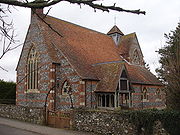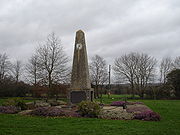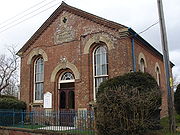
Leckhampstead, Berkshire
Encyclopedia



Village
A village is a clustered human settlement or community, larger than a hamlet with the population ranging from a few hundred to a few thousand , Though often located in rural areas, the term urban village is also applied to certain urban neighbourhoods, such as the West Village in Manhattan, New...
and civil parish in Berkshire
Berkshire
Berkshire is a historic county in the South of England. It is also often referred to as the Royal County of Berkshire because of the presence of the royal residence of Windsor Castle in the county; this usage, which dates to the 19th century at least, was recognised by the Queen in 1957, and...
, England
England
England is a country that is part of the United Kingdom. It shares land borders with Scotland to the north and Wales to the west; the Irish Sea is to the north west, the Celtic Sea to the south west, with the North Sea to the east and the English Channel to the south separating it from continental...
lying in the North Wessex Downs. It is a mixture of modern and more traditional thatched
Thatching
Thatching is the craft of building a roof with dry vegetation such as straw, water reed, sedge , rushes, or heather, layering the vegetation so as to shed water away from the inner roof. It is a very old roofing method and has been used in both tropical and temperate climates...
houses.
It is located in the West Berkshire
West Berkshire
West Berkshire is a local government district in the ceremonial county of Berkshire, England, governed by a unitary authority . Its administrative capital is Newbury, located almost equidistantly between Bristol and London.-Geography:...
district, north of the M4 motorway
M4 motorway
The M4 motorway links London with South Wales. It is part of the unsigned European route E30. Other major places directly accessible from M4 junctions are Reading, Swindon, Bristol, Newport, Cardiff and Swansea...
lying just off the road between Newbury
Newbury, Berkshire
Newbury is a civil parish and the principal town in the west of the county of Berkshire in England. It is situated on the River Kennet and the Kennet and Avon Canal, and has a town centre containing many 17th century buildings. Newbury is best known for its racecourse and the adjoining former USAF...
about 6 miles (9.7 km) to the south-southeast and Wantage
Wantage
Wantage is a market town and civil parish in the Vale of the White Horse, Oxfordshire, England. The town is on Letcombe Brook, about south-west of Abingdon and a similar distance west of Didcot....
about
12.5 miles (20 km) to the north-northwest. The town of Hungerford
Hungerford
Hungerford is a market town and civil parish in Berkshire, England, 9 miles west of Newbury. It covers an area of and, according to the 2001 census, has a population of 5,559 .- Geography :...
is about 12.5 miles (20 km) to the southwest.
Nearby villages include Chieveley
Chieveley
Chieveley is a village and civil parish about north of Newbury in Berkshire, close to the M4 motorway and A34 road.-Character:Chieveley is a village of 1,481 people and 508 households. A map of 1877 stated the area at the time to be roughly . Chieveley Service Station serves Junction 13 of the M4...
, Boxford
Boxford, Berkshire
Boxford is a village and civil parish in the unitary authority of West Berkshire, part of Berkshire in England.The village is on the east bank of the River Lambourn, about northwest of Newbury but south of the M4 motorway...
, Chaddleworth
Chaddleworth
Chaddleworth is a village and civil parish in the English county of Berkshire.-Geography:The village of Chaddleworth lies below the southern slopes of the Berkshire Downs, just east of the A338 road, which runs between Hungerford and Wantage to form the western parish boundary...
, Brightwalton
Brightwalton
Brightwalton is a village and civil parish in the Berkshire Downs about north of Newbury in West Berkshire. It has a population of 322.The history of the Church of England parish church of All Saints goes back at least as far as the Domesday Book of 1086. The building was demolished in 1863 and...
and Peasemore
Peasemore
Peasemore is a village and civil parish in the English county of Berkshire in the United Kingdom. It is located in the West Berkshire unitary authority, west of the A34 road and north of the town of Newbury.-Amenities:...
.
History
A number of Bronze AgeBronze Age
The Bronze Age is a period characterized by the use of copper and its alloy bronze as the chief hard materials in the manufacture of some implements and weapons. Chronologically, it stands between the Stone Age and Iron Age...
features have been recorded near Leckhampstead and a flint arrowhead of this period has been found.
Roman finds include a 2nd century earring and Samian ware.
An 11th century church has been recorded about 0.6 mile (0.965604 km) east of the present church near present day Chapel Farm.
Leckhampstead was recorded in the Domesday Book
Domesday Book
Domesday Book , now held at The National Archives, Kew, Richmond upon Thames in South West London, is the record of the great survey of much of England and parts of Wales completed in 1086...
in 1086 as Lecanestede and was owned by Abingdon Abbey
Abingdon Abbey
Abingdon Abbey was a Benedictine monastery also known as St Mary's Abbey located in Abingdon, historically in the county of Berkshire but now in Oxfordshire, England.-History:...
.
A medieval deer park
Medieval deer park
A medieval deer park was an enclosed area containing deer. It was bounded by a ditch and bank with a wooden park pale on top of the bank. The ditch was typically on the inside, thus allowing deer to enter the park but preventing them from leaving.-History:...
existed about 1228.
Points of interest
The small, brick and flintFlint
Flint is a hard, sedimentary cryptocrystalline form of the mineral quartz, categorized as a variety of chert. It occurs chiefly as nodules and masses in sedimentary rocks, such as chalks and limestones. Inside the nodule, flint is usually dark grey, black, green, white, or brown in colour, and...
church of St James, built in 1859, lies towards the southern end of the village. It was designed by the notable church architect
Architect
An architect is a person trained in the planning, design and oversight of the construction of buildings. To practice architecture means to offer or render services in connection with the design and construction of a building, or group of buildings and the space within the site surrounding the...
, Samuel Sanders Teulon
Samuel Sanders Teulon
Samuel Sanders Teulon was a notable 19th century English Gothic Revival architect.-Family:Teulon was born in Greenwich in south-east London, the son of a cabinet-maker from a French Huguenot family. His younger brother William Milford Teulon also became an architect...
. The interior is brick with patterns formed by the use of differently coloured bricks.
The public house
Public house
A public house, informally known as a pub, is a drinking establishment fundamental to the culture of Britain, Ireland, Australia and New Zealand. There are approximately 53,500 public houses in the United Kingdom. This number has been declining every year, so that nearly half of the smaller...
in the village is called The Stag.
There is an unusual war memorial
War memorial
A war memorial is a building, monument, statue or other edifice to celebrate a war or victory, or to commemorate those who died or were injured in war.-Historic usage:...
on the triangular village green
Village green
A village green is a common open area which is a part of a settlement. Traditionally, such an area was often common grass land at the centre of a small agricultural settlement, used for grazing and sometimes for community events...
. It comprises an obelisk on a plinth with two clock faces, one facing north and one facing south, which incorporate various types of ammunition
Ammunition
Ammunition is a generic term derived from the French language la munition which embraced all material used for war , but which in time came to refer specifically to gunpowder and artillery. The collective term for all types of ammunition is munitions...
in them. The chains surrounding the monument are from a battleship
Battleship
A battleship is a large armored warship with a main battery consisting of heavy caliber guns. Battleships were larger, better armed and armored than cruisers and destroyers. As the largest armed ships in a fleet, battleships were used to attain command of the sea and represented the apex of a...
that took part in the Battle of Jutland
Battle of Jutland
The Battle of Jutland was a naval battle between the British Royal Navy's Grand Fleet and the Imperial German Navy's High Seas Fleet during the First World War. The battle was fought on 31 May and 1 June 1916 in the North Sea near Jutland, Denmark. It was the largest naval battle and the only...
and they are supported on spent shell cases.
The Hangman’s Stone is a boundary stone
Boundary marker
A boundary marker, boundary stone or border stone is a robust physical marker that identifies the start of a land boundary or the change in a boundary, especially a change in a direction of a boundary...
lying about a mile south of the village at . It gets its name from a local tale which tells of a sheep rustler who was carrying a stolen sheep over his shoulder with a rope held around his neck. Feeling tired the thief sat on a stone beside the road and fell asleep. The sheep, in struggling to get free, hanged the man by the rope that had remained around his neck. The stone has given its name to the road which passes it, Hangman’s Stone Lane, which leads to the village of Boxford
Boxford, Berkshire
Boxford is a village and civil parish in the unitary authority of West Berkshire, part of Berkshire in England.The village is on the east bank of the River Lambourn, about northwest of Newbury but south of the M4 motorway...
.
Leckhampstead Thicket
Leckhampstead Thicket is a hamletHamlet (place)
A hamlet is usually a rural settlement which is too small to be considered a village, though sometimes the word is used for a different sort of community. Historically, when a hamlet became large enough to justify building a church, it was then classified as a village...
that lies between Leckhampstead and Chaddleworth . There are a number of thatched cottages and a chapel, dated 1874, which is one of the very few Primitive Methodist
Primitive Methodism
Primitive Methodism was a major movement in English Methodism from about 1810 until the Methodist Union in 1932. The Primitive Methodist Church still exists in the United States.-Origins:...
chapels still in use.

